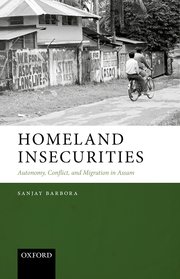
Sanjay Barbora’s book Homelands Insecurities: Autonomy, Conflict, and Migration in Assam (published by Oxford University Press in 2022), is an in-depth sociological analysis of political and social issues that have shaped the lives of ordinary people in Assam since the early post-colonial era and the Assam agitation of the 1980s. He presents us with thick ethnographic accounts of people on the ground and insights from his engagements as a human rights activist for over two decades in the region. In doing so, he critically examines the social relations, the changing socio-economic aspirations and everyday politics of the people in the broader context of debates on citizenships, autonomy, migration, reconciliation, conflicts and wildlife conservation politics in contemporary Assam. He discussed these broad themes across six chapters in the book.
Needless to say, Barbora’s book comes as an honest scholarly intervention at a time when Assam is yet to overcome the National Register of Citizens (NRC) and Citizenship (Amendment) Act (CAA) anxieties that are set to exclude millions of people from citizenship lists, mostly the poor and Muslim minorities of Bengali origin. Barbora asserts that both the NRC process and CAA have miserably failed to address the desired outcomes of social justice and political stability. Instead, a combination of these issues has further divided the people of Assam based on ethnic and religious lines, resulting in a deeply polarised Assam, defined by a strong anti-Muslim rhetoric. Barbora’s work goes beyond this rhetoric. He tells us that the issues of citizenship and NRC in Assam are embedded in a socio-political process that is complex and needs to be analysed historically and sociologically.
The book discusses the politics of autonomy demands in Assam, an ethnicity-based political movement for self-determination and self-governance of their territories and resources. Barbora adds that the legal and political framework in which autonomy has been granted in Assam is inefficient in facilitating dialogue and reconciliation among the different communities. Here, he maintains that granting autonomy has addressed certain anxieties of some ethnic groups, but the absence of dialogue on the issues that have driven these anxieties continues to disturb the peaceful co-existence of larger diverse ethnic communities in Assam that live in autonomous areas. He helps us understand those anxieties through critical engagements with the issues of insurgency, counterinsurgency and ethnic conflicts that have resulted from territorial and political autonomy movements in contemporary Assam.
Barbora’s work further captures the precarious conditions of internally displaced persons in Assam created by the conflict-induced displacement and natural disasters closely connected to the increasing impacts of climate change in the region. With regards to the matter of migration, Barbora talks not only about immigration into Assam but also draws the readers’ attention to the emigration of youths from the state, which otherwise is a rarely discussed subject. Barbora’s work apprises that the immigration issue in Assam has its root in the colonial past and the partition, involving socio-political violence, which still informs the political debates in contemporary Assam. He similarly illuminates the issue of youth emigration from Assam in relation to the conflicts that have led to decades of political violence and social unrest, forcing many youngsters to leave their homes in search of better opportunities outside the state. In this way, he pushes us to think through the common threads and delve into the shared insecurities and violence that have compelled the people cutting across the communities and borders to leave their homelands.
Subsequently, the book provides us with insightful perspectives on how the migrant and non-human elements (like the rhinos and elephants) have emerged as significant categories concerning wildlife conservation discourse in present-day Assam. He contextualised the layered ground realities that are driving Assam’s complex political ecology and wildlife conservation politics through his field engagements with multiple stakeholders such as forest officials, activists, conservationists, and communities, among others. Barbora’s work on debates around encroachment of reserved forests, poaching of rhinos and elephant-human conflict, for instance, highlights the complicated relationships different stakeholders share in negotiating and understanding the environment/conservation practices in Assam. Here, Barbora allows us to holistically understand the dynamic multi-dimensional factors that shape the narratives of conservation discourse and practices in contemporary Assam, which is usually missing in the mainstream media and scholarly work.
Undoubtedly, the scholarship of this book is a crucial contribution to social sciences studies in Assam and the northeast in general. Barbora’s book captures the complexities of tragedies and the possibilities of hopes concerning everyday shared insecurities that divide and bind the communities in Assam. By doing this, he presses us to critically engage and broaden our perspectives to understand the issues of autonomy, insurgency, reconciliation, migration, conflict, and conservation politics in contemporary Assam. Ultimately, he brings out the complex realities and voices from the margins and also captures the intimate linkages of micro and macro processes, thereby drawing our attention to the fact that what is now happening in Assam has a wider connection emerging across the globe.
***
Manta Wangsu is a PhD research scholar in the School of Social Sciences and Humanities, Indraprastha Institute of Information Technology, Delhi (IIITD).